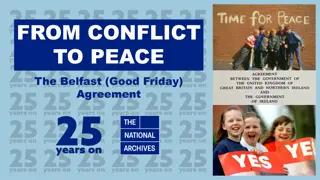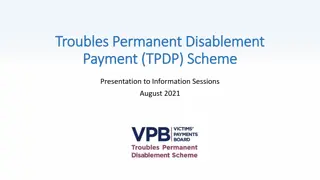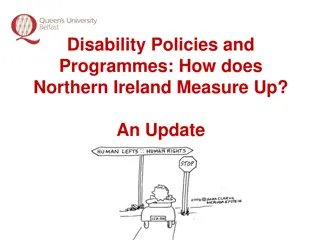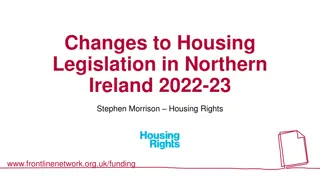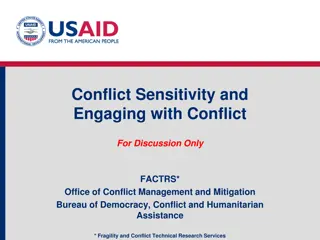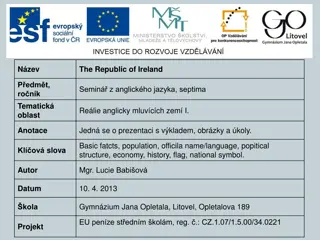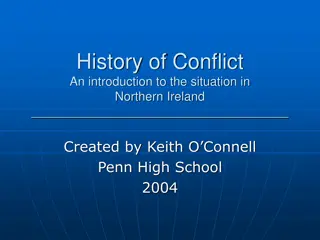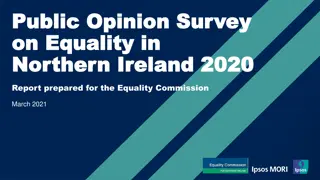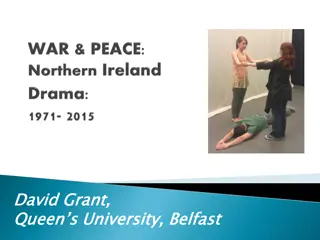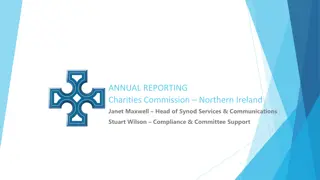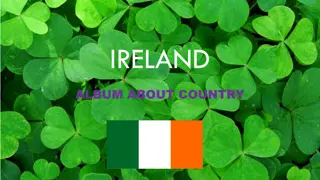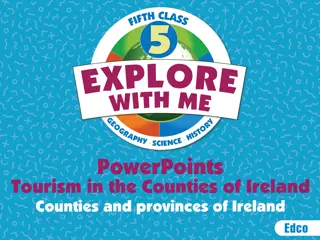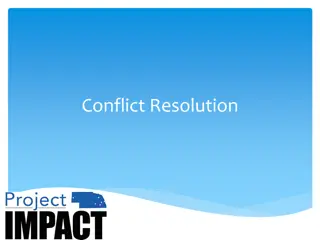The Troubles in Northern Ireland: A Decades-Long Conflict
The Troubles in Northern Ireland, spanning from the 1970s to the 1990s, involved violent clashes between paramilitary groups representing Loyalists and Nationalists. British troops were deployed to manage the conflict, which intensified with deadly bombings, shootings, and protests, particularly by the IRA. The infamous Bloody Sunday in 1972, where British troops killed 14 civilians, garnered international attention. The period also saw hunger strikes by IRA prisoners and ongoing tensions in Northern Ireland.
Download Presentation

Please find below an Image/Link to download the presentation.
The content on the website is provided AS IS for your information and personal use only. It may not be sold, licensed, or shared on other websites without obtaining consent from the author. Download presentation by click this link. If you encounter any issues during the download, it is possible that the publisher has removed the file from their server.
E N D
Presentation Transcript
Guided Reading (within six step model) TASK 1 - Reading Comprehension BEFORE WE READ 1. Write down what you already know about this topic: Type here 1. Complete the first box by writing what you already know about this topic. 2. Then, complete the second box, predicting what you think the text will be about. 2. Read the title of the text: predict what you think the author will say and why you think this: To do this, think about: The title of the article what interpretation (view) do you think the author will convey? Type here E.g. Is it an objective title (doesn t suggest it has an opinion) or is it an opinionated title?
Guided Reading (within six step model) TASK 1 - Reading Comprehension DURING READING 1. We will read the text through together once (next slide). As we read, highlight/underline/write down any words you don t understand. Find out the definitions. 2. Read the text again independently, one paragraph at a time, using the strategies below 3. Complete the left column (a title/heading for the paragraph) and right column (summarise into 2-3 points) Reading Strategies SCAN the text for words/facts you recognise from your own knowledge highlight them SKIM the text read the paragraph to get the gist (overall message) of what it s saying SUMMARISE each paragraph into one sentence by scanning and skimming (write this in box 4) STRUCTURE look at the conventions and think about why they use them: are the paragraphs in a certain order? Do they use subheadings? Do they use sources/diagrams? Do they use quotes or references from other historians? Do they use statistics? A mural depicting Bloody Sunday .
Add a title for each paragraph Summarise each paragraph in your own words in 2-3 bullet points The Troubles in Northern Ireland From the 1970s to the 1990s, there was a lot of fighting between paramilitary groups on both sides and many people died in the violence. In order to deal with the conflict, British troops were sent to the area (1969), but they came into conflict with Republican armed groups, the largest of which was the Irish Republican Army (IRA). The Loyalist paramilitary group was the Ulster Volunteer Force. The IRA carried out deadly bombings in Britain and Northern Ireland. Armed Loyalists also carried out violence. The IRA in particular targeted the police and soldiers from the British army who patrolled the streets. The situation became much worse in January 1972, when 14 people were killed by British troops during a peaceful civil rights march led by Catholics and Republicans in Derry/Londonderry. This day became known as Bloody Sunday. Journalists captured the event on film and the world was outraged. In April 1972, the British government released a report clearing British troops of any illegal actions during the Derry/Londonderry protest. What were The Troubles ? It took place from 1970s- 1990s. Violence was between Loyalists and Nationalists. British troops were sent over to try to maintain control. Type here Type here Type here Type here
Add a title for each paragraph The Troubles in Northern Ireland Summarise in 2-3 bullet points Irish anger grew and Britain increased its military presence in the North while removing any trace of Northern self-rule. On July 21, 1972, the IRA exploded around 21 bombs simultaneously in Belfast, killing British military personnel and a number of civilians. In 1981, 10 IRA prison hunger strikers starved to death after they used hunger strikes to protest against losing their political prisoner status and against wearing prison uniforms. For years afterwards many doubted that it would be possible to bring peace to Northern Ireland. After years of fighting, the 1990s saw a change in the region, as the IRA announced it would stop the bombings and shootings. This gave the Unionists and Nationalists the opportunity to try to sort out their problems. It was not an easy process, and other countries got involved to help the two sides to reach a deal. In 1998, after nearly two years of talks and 30 years of conflict, the Good Friday Agreement was signed. This resulted in a new government being formed that would see power being shared between Unionists and Nationalists. A copy of the agreement was posted to every house in Northern Ireland and the Republic of Ireland for people to read, before a referendum was held when they could vote on it. In May 1998, adults in Northern Ireland and the Republic of Ireland voted in favour of the Good Friday Agreement (71%), which made it official - and the Northern Ireland Assembly took their seats in December of that year. Type here Type here Type here Type here Type here Type here Type here Type here
Guided Reading (within six step model) TASK 1 - Reading Comprehension AFTER READING 3. Summarise the text into 1-3 key points: 1. 1. Summarise your points into 1-3 points. Your challenge task is to summarise the whole text into 1 point. 2. 3. 2. Complete the final box by thinking about which strategies you used (use the box below to help) and which strategies you found helpful. Reading Strategies 4. What strategies did you use to try to understand the text? E.g. skimming, scanning, looking up definitions, re-reading etc. SCAN the text for words/facts you recognise from your own knowledge highlight them SKIM the text read the paragraph to get the gist (overall message) of what it s saying SUMMARISE each paragraph into one sentence by scanning and skimming (write this in box 4) STRUCTURE look at the conventions and think about why they use them: are the paragraphs in a certain order? Do they use subheadings? Do they use sources/diagrams? Do they use quotes or references from other historians? Do they use statistics?




